Monday’s Essential Report had its usual Approval Ratings and Better PM questions that we quickly mentioned last post, but it’s worth having a closer squiz at the way the gender breakdowns have been tracking.
First up, the approvals:
Now, onto the Better PM results.
Back when the campaign first started and up to around the time of the leaders debate, Gillard was enjoying a substantial lead in the polls, with our Phone Pollster Trend sitting on over 52% and where the three most recent phone polls had spiked for Labor at 54% (Nielsen), 55% (Newspoll) and 55.5% (Morgan’s phone poll).
At the time, Gillard was not only much stronger among females than Abbott was among males, but Gillard was also much stronger among voters under 40 than Abbott was among voters over 55 – giving Labor a substantial overall lead, simply because the magnitude of Gillard’s strengths were larger than the magnitude of Abbott’s.
However, this doesn’t quite tell the full story. The strength of Gillard’s female vote came mostly from younger women while the strength of Abbotts male vote came more from older men than younger men, even though all men as a block leaned toward Abbott.
Older women on the other hand, were much more evenly divided- voting pretty much along the lines of the national average level for each Party.
This also came out in the Polliegraph of the leaders debate. If we look at around two minutes of the closing remarks of each leader and track the responses of four separate demographic blocks -females under 45, females over 45, males under 45 and males over 45 – we can see the solid pro-Gillard, anti-Abbott results among women under 45 and how it was different to older women, and significantly different to men of either age cohort.(Gillard first, then Abbott – click to expand)
But a funny thing happened on the way to the election, which was summed up well by Monday’s Essential question on how opinion on the leaders and their party’s have changed over the campaign period. The question went:
Since the election was called has your opinion of Julia Gillard/Tony Abbott and the Labor/Liberal Party gone up or down?
Abbott appears to have kept his known quality position – with partisan movement from either side cancelling out any overall net opinion change. Gillard, however, has had a campaign that is overwhelmingly seen to have reduced the public’s opinion of Gillard and the Labor Party. If we look at how this broke down by gender, we get:
This pretty much explains the reduction in the size of the gender gap we’ve seen over the campaign in the vote estimates – but where the reduction in the overall magnitude of that gender gap has come from women reducing their support levels for Gillard while Abbott has approximately maintained his support levels among men. Also worth noting is that uncommitted numbers on satisfaction/approval ratings and Better/Preferred PM numbers have generally shown women to outnumber men.
Part of what makes this election unusual (because, you know, the most popular government in Australia’s history removing the country’s most popular ever leader because he tanked and replacing him with the nation’s first ever female PM isn’t unusual enough!) is the swapping of gender strengths since the last election. In 2007, Labor had around 4 points more men than women on their primary vote, while now it’s the opposite. The Coalition had around two points more women than men on their primary vote, now it too is the opposite.
This is important, because the number of people that will have actually changed their party vote since 2007 will be much, much larger than whatever the national swing is on August 21. So if Labor wins with, say (picking a random number) 52% – the national swing will have only been 0.7% towards the Coalition, which would be less than 1 in 100 people changing their vote in net terms. However, the reality underneath would actually be more like 15 to 20% of the population changing their vote if we just look at the current and recent gender breakdowns alone. If undecided men and women split strongly along gender, it will be larger still.
So whatever the ultimate result this election actually is, it will mask a much larger change in the political landscape than the raw top line numbers would suggest – so much so, that it will probably be a larger shift in terms of the proportion of the population that changed their vote in one electoral cycle than what occurred between the 2004 and 2007 election.
Oh, and the Coalition released a broadbandish telecommunications policy yesterday. Here’s part of it:
[youtube]https://www.youtube.com/watch?v=z5ELj5HpV0E[/youtube]

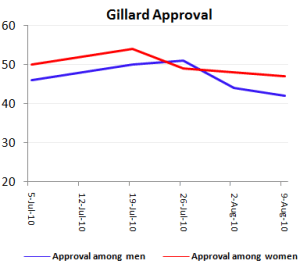
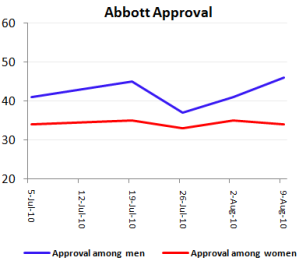
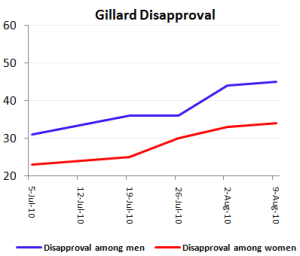
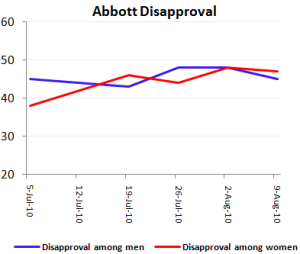
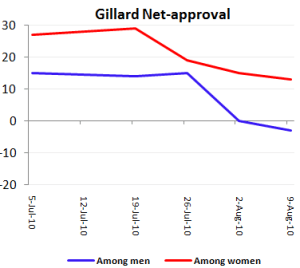
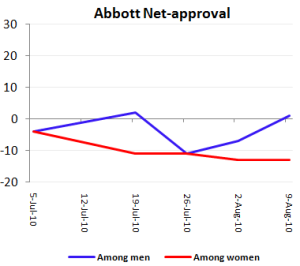
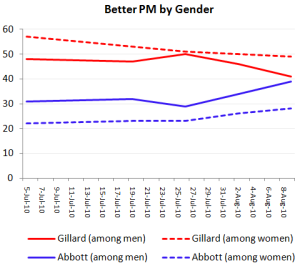
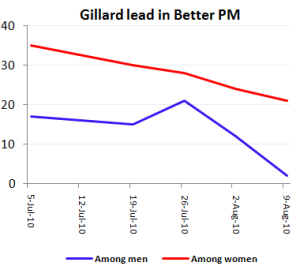


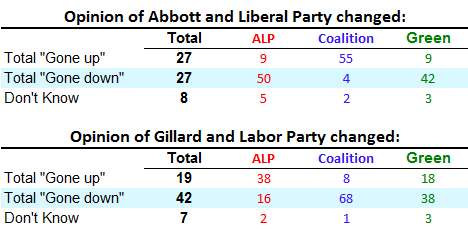







Crikey is committed to hosting lively discussions. Help us keep the conversation useful, interesting and welcoming. We aim to publish comments quickly in the interest of promoting robust conversation, but we’re a small team and we deploy filters to protect against legal risk. Occasionally your comment may be held up while we review, but we’re working as fast as we can to keep the conversation rolling.
The Crikey comment section is members-only content. Please subscribe to leave a comment.
The Crikey comment section is members-only content. Please login to leave a comment.